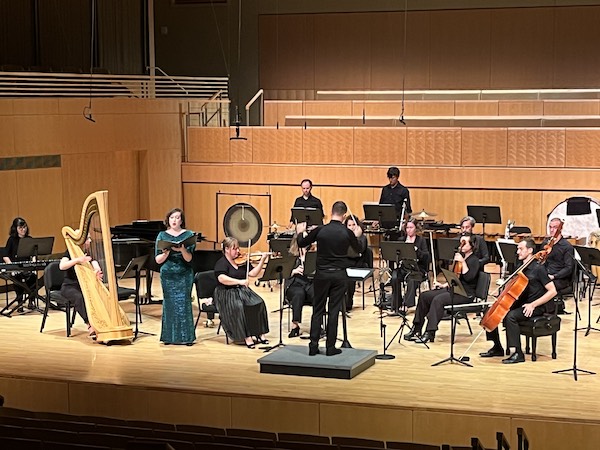Inscape revels in chamber rarities in scintillating UMBC concert

Soprano Mandy Brown performed Kaija Saariaho’s Quatre Instants with the Inscape Chamber Orchestra Sunday at Linehan Concert Hall. Photo: Jim Williams
Inscape Chamber Orchestra, a group known for its innovative reepertoire, brought another distinctive program Sunday afternoon to the new UMBC series at Linehan Concert Hall. Artistic director Richard Scerbo conducted an eclectic combination of rarely heard music by two Finnish composers and a Dane.
The concert opened with Esa-Pekka Salonen’s Fog, composed in 2019, and proceeded backward chronologically from there. The piece was written for the 90th birthday of architect Frank Gehry, the designer of Walt Disney Concert Hall, which the Los Angeles Philharmonic now calls home. Salonen led that orchestra from 1992 to 2009, composing this piece at the end of a break he took from conducting.
Salonen derived much of the piece from the Prelude to Bach’s Violin Partita No. 3. The composer recalled in an interview that L.A. Phil concertmaster Martin Chalifour played that piece as the first test of the acoustics of Disney Hall, while it was still under construction. To introduce the Salonen work, violinist Rebecca Racusin Almog gave a sparkling rendition of the Bach from the left balcony, just as Chalifour had done in the presence of Salonen and Gehry.
Salonen recombined the rhythmic pulse of the Bach piece through metric distortion, so that elements of the source music float up in the swirling texture. The thirteen Inscape players brought out the bariolage elements, a signature part of the Prelude, with the jauntiest bits enlivened by the whimsical sound of bongos. Pianist Josephine Riggs gave improvisatory flair to the little cadenza that marked a break in the piece, and Evan Ross Solomon’s bass clarinet sounded at one point like a fog horn in the mist.
The song cycle Quatre Instants, composed in 2002 by the late Kaija Saariaho, evoked a different kind of fog, the blind confusion of desire. Created by and dedicated to the Finnish soprano Karita Mattila, these four songs feel like an extension of Saariaho’s celebrated opera L’Amour de Loin, premiered two years earlier. Her librettist for that work, Lebanese-French writer Amin Maalouf, also wrote these poems.
Soprano Mandy Brown sang the vocal part with consummate poise, her top range warm and powerful but also capable of a limpid shimmer. The panicked refrain (“Le remords me brûle”) of the second song rang out, echoed by terrified responses in the violin. Saariaho herself created this version for chamber orchestra, with slight differences from the original for soprano and piano. Inscape’s musicians wove a hazy gauze around Brown’s voice, with cantillating winds and shivering bar chimes and other metallic sounds.
The third song, “Parfum de l’instant,” proved the most evocative of the set, with Brown’s radiant high notes echoed by violin, flute, and harp, imparting the feeling of sexual tension. The only shortcoming was the celesta part, not the fault of the performer, Guzal Isametdinova, but because of the canned sound of the amplified synthesizer taking its place. Brown’s musicality astounded, more so because she was so accurate in terms of intonation and execution.
A welcome performance of Carl Nielsen’s Sixth Symphony (mischievously titled “Sinfonia semplice”) rounded out this knock-out concert. Completed in 1925 as the Danish composer’s final symphony, this odd work fared rather well in an even odder chamber orchestra transcription by Hans Abrahamsen. Scerbo’s crisply defined gestures on the podium gave all three pieces crystalline clarity.
Nielsen’s eccentric use of percussion, from the one-note opening solo for glockenspiel, required a battery of three players, with the harmonium player even asked to double on bass drum at one point in the fourth movement. The first movement’s crazy passage for glockenspiel, triangle, and piccolo was balanced by lush playing from the five string players. The whole ensemble of eighteen musicians produced chaotic masses of sound in the two outbursts thought to be musical descriptions of the heart attacks that Nielsen had recently suffered.
The “Humoreske” movement retained all of its surprising zaniness, including the surfeit of percussion in the introduction. The middle section, initially a goofy clarinet tune, featured James Anderson’s outsized glissandi on the trombone. Some of the warmth of the third movement (“Proposta seria”) was lost in the reduction to just five string players, but the poignancy of this moment of reflection remained. Again, sadly, the decision to render the harmonium part on the synthesizer was regrettable.
Nielsen concluded his symphonic output with a truly bizarre Finale, a theme and variations that goes from fanfare to circus march and back again. In the wide-ranging variations, bassoonist Erich Heckscher stood out for his lovely solo, and Josephine Riggs excelled on the whirling-dervish piano part. To get across the point that we had progressed from G major in the first movement to B-flat major at the end, Nielsen gave the last word to the bassoon, which blurted out a triumphantly held, low B-flat.
Violinist Fangming Shen and pianist Hsiao-Ying Lin perform music of Bach, Szymanowski, Ravel, and Beethoven 3 p.m. November 5. umbc.edu


